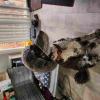Hi All,
We just noticed that an entire pallet of nonfat dried milk powder (40 lb. bags) has been dripped on by a leaking roof and the outside of the bags has what appears to be mold spots all over them. The bags are lined with plastic, so it is possible that the actual powder is not in contact with the mold.
This ingredient is added to a batch of milk, then pasteurized before packaging the finished product.
The pallet has been placed on hold until we can assess the situation. My initial reaction is not to use any of it, however I am getting pushback from management to salvage as much as possible. How would you handle this?
Thanks in advance for your advice!
Sarah













